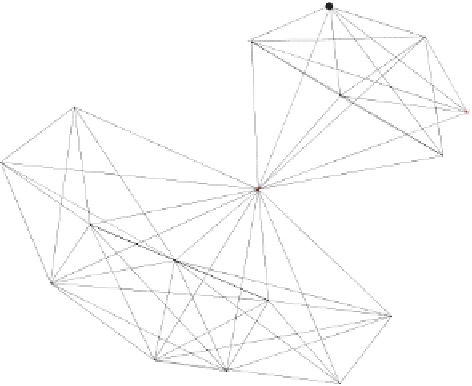Information Technology Reference
In-Depth Information
k-dense community
AMP
LOUD
STEREO
k-clique communities
SPEAKER
WOODWIND
SOUND
RADIO
OBOE
MUSIC
CLARINET
INSTRUMENT
FLUTE
TROMBONE
TUBA
TRUMPET
SAXOPHONE
BAND
Fig. 14.6.
An visualized example of
k
-dense and
k
-clique communities extracted from
the word association network
Figure 14.6 shows visualization results of communities extracted by the
k
-
dense method and the
k
-clique method at
k
= 6. Here the spring method pro-
posed by Kamada and Kawai [8] is employed for visualization. As shown in
this figure, the
k
-dense method extracts the subnetwork as only one community,
while the
k
-clique method decomposes it into the three communities, allowing
node overlaps, i.e., the node labeled “MUSIC”, for example, belongs to all three
6-clique communities. In this example, we admit that it is arguable whether we
should allow node overlapping or not and whether we should decompose it into
three communities or treat it as one community. At least by directly visualizing
the subnetwork extracted by the
k
-dense method, which is substantially easier
than visualizing the whole original network, it would be possible for us to easily
find such substructures without farther decompositions. In addition, this sub-
network is an example that any of the
h
-level
k
-dense community with
h
≥
2is
the same.
14.3.4
Evaluation Using Wikipedia Reference Network
We have applied the
k
-dense and
k
-core methods to the Wikipedia reference
network labeled
Wikipedia
in Table 14.1. It was not possible, at least for us,
to apply the
k
-clique method by using the CFinder program [10] to this large
Wikipedia reference network with 536,724 nodes and 1,337,902 links. The result
of the
k
-dense method shows that
k
max
= 36, while the result of the
k
-core
method shows that
k
max
= 48.




















